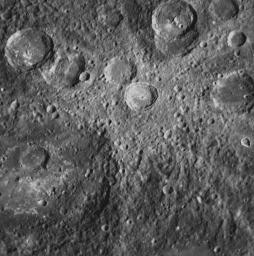
|
Fading Away
- Click the image above for a larger view
- Full-Res JPEG (1018 x 1024) (179.3 kB)
- Full-Res TIFF (1018 x 1024) (1.0 MB)
Caption:
This NAC image from MESSENGER's second Mercury flyby shows a crater with a set of light-colored rays radiating outward from it. Such rays are formed when an impact excavates material from below the surface and throws it outward from the crater. These bright rays, consisting both of ejecta and the secondary craters that form when the ejected material re-impacts the surface, slowly begin to fade as they are exposed to the harsh space environment. Mercury and other airless planetary bodies are constantly being bombarded with micrometeorites and energetic ions, an effect known as space weathering. Craters with bright rays are thought to be relatively young because the rays are still visible, suggesting that they have had less exposure to weathering processes. The crater in the center of this image has rays that have already begun to fade, implying that it is older than some other rayed craters on Mercury's surface. Images of younger craters with much brighter and more striking rays have been previously released (see PIA11355 ).
Date Acquired:
October 6, 2008
Image Mission Elapsed Time (MET):
131771863
Instrument:
Narrow Angle Camera (NAC) of the Mercury Dual Imaging System (MDIS)
Resolution:
240 meters/pixel (0.15 miles/pixel)
Scale:
Image is approximately 240 kilometers (150 miles) wide
Spacecraft Altitude:
9,500 kilometers (5,900 miles)
Background Info:
These images are from MESSENGER, a NASA Discovery mission to conduct the first orbital study of the innermost planet, Mercury. For information regarding the use of images, see the MESSENGER image use policy .
Cataloging Keywords:
| Name | Value | Additional Values |
|---|---|---|
| Target | Mercury | |
| System | ||
| Target Type | Planet | |
| Mission | MESSENGER | |
| Instrument Host | MESSENGER | |
| Host Type | Orbiter | |
| Instrument | Mercury Dual Imaging System (MDIS) | |
| Detector | Narrow Angle Camera (NAC) | |
| Extra Keywords | Crater, Grayscale, Impact | |
| Acquisition Date | ||
| Release Date | 2009-06-09 | |
| Date in Caption | 2008-10-06 | |
| Image Credit | NASA/Johns Hopkins University Applied Physics Laboratory/Carnegie Institution of Washington | |
| Source | photojournal.jpl.nasa.gov/catalog/PIA12068 | |
| Identifier | PIA12068 | |
